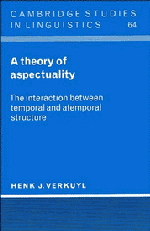Book contents
- Frontmatter
- Contents
- Preface
- Acknowledgments
- PART I ISSUES OF COMPOSITIONALITY
- PART II NOUN PHRASE STRUCTURE
- PART III TEMPORAL STRUCTURE
- 9 Homogeneity
- 10 Localism and additive structure
- 11 Event semantics and aspect construal
- 12 Aspect and perspective
- 13 Event construal
- 14 Testing the Plus-principle
- Conclusion to Part III
- Notes
- References
- Index
10 - Localism and additive structure
Published online by Cambridge University Press: 05 July 2011
- Frontmatter
- Contents
- Preface
- Acknowledgments
- PART I ISSUES OF COMPOSITIONALITY
- PART II NOUN PHRASE STRUCTURE
- PART III TEMPORAL STRUCTURE
- 9 Homogeneity
- 10 Localism and additive structure
- 11 Event semantics and aspect construal
- 12 Aspect and perspective
- 13 Event construal
- 14 Testing the Plus-principle
- Conclusion to Part III
- Notes
- References
- Index
Summary
Introduction
In this chapter, three issues are central. The first one follows naturally from the line of argument in chapter 9. It will be argued in section 10.1 that the notion of homogeneity may apply to verbs but that this notion then is no longer of interest for aspectual theory. In terms of Taylor's sultana metaphor: the VP walk to Rome should not bear comparison with a fruit-cake, nor the VP walk in John walked with gold, or cake for that matter. By dealing with the sultana-issue at the level of lexical knowledge, one clears the way for a different approach in which the verb and its complement have different contributions to make.
This opens up the second issue: the verb induces temporal structure to which the information associated with its complement systematically relates. As a result, the notion of Path emerges: the fusion of temporal and atemporal structure which can be bounded (terminative) or unbounded (durative). The contribution of verbs expressing change to the construction of temporal structure will be discussed in section 10.2 as a first leg up to formalization in chapter 13.
The third issue is built on top of the others: the question is what the terminative (47), (48), (50) and (51) have in common, and what the durative sentences (49) and (52). For (48) and (51) this question can be made more concrete: if there is a mapping between the temporal structure induced by eat and the set of three sandwiches, what is the mapping relation between the walk-structure and the denotation of the PP-complement (including the preposition)?
Information
- Type
- Chapter
- Information
- A Theory of AspectualityThe Interaction between Temporal and Atemporal Structure, pp. 215 - 241Publisher: Cambridge University PressPrint publication year: 1993
